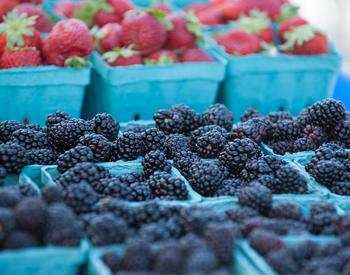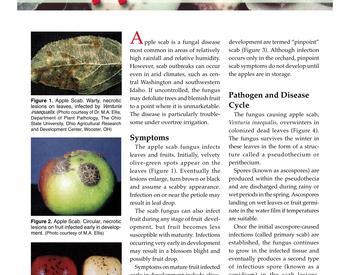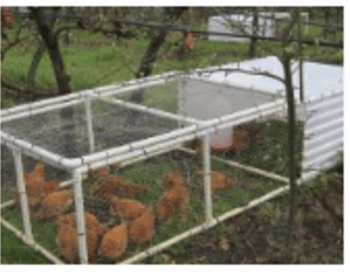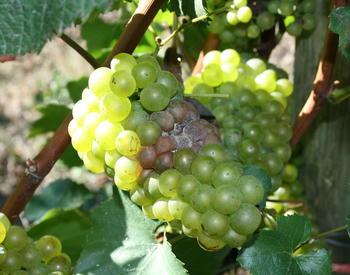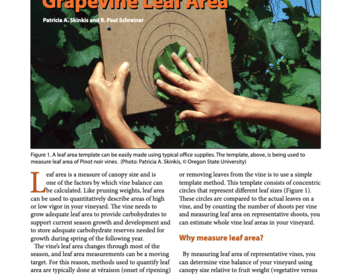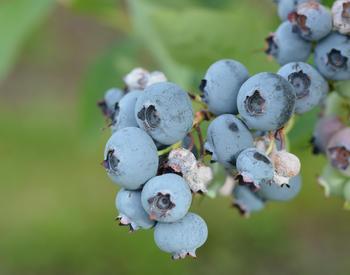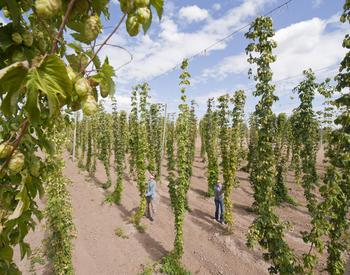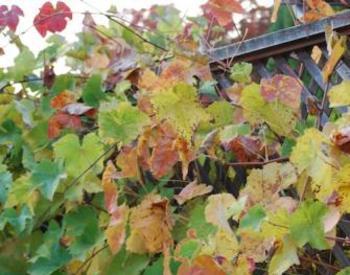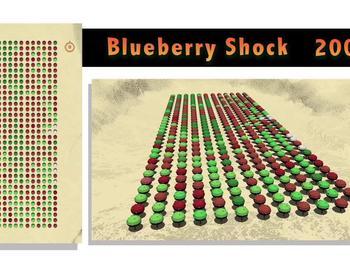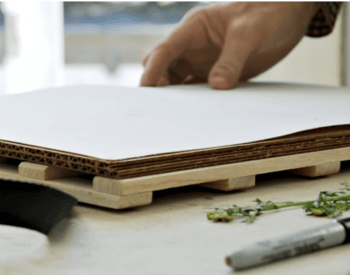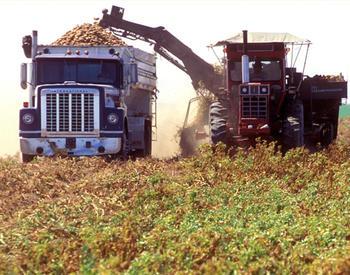While blueberries grow well in the Pacific Northwest, five major viruses afflict plants in this region. Learn what you need to know to prevent and manage viral disease in your blueberry plants.
The viruses of major concern in this region include blueberry scorch virus, blueberry shock virus, tomato ringspot virus, blueberry fruit drop-associated virus and blueberry mosaic-associated virus. Management strategies depend on what stage your fields are in — site selection and preparation, or fields in full production. It's also helpful to look at viruses not present in the Pacific Northwest. The most effective management for viruses not already present is to keep them out of the production region.
Virus diseases of major importance in the Pacific Northwest
For photos and more discussion of blueberry viruses, see the Pacific Northwest Plant Disease Handbook.
Scorch
Blueberry scorch disease was first reported in 1980 in a field near Puyallup, Washington, and Blueberry scorch virus (BlScV) initially was characterized from two fields in Washington in 1988. The disease has since been detected in three fields in Oregon and several more in Washington. The virus is also the causal agent of Sheep Pen Hill Disease described in New Jersey in 1970. The disease was first reported in British Columbia in 2000 and has since been found to be widespread there, while still limited in its distribution in Oregon and Washington. The disease has also been reported in Connecticut, Massachusetts, Michigan, New York and Pennsylvania, as well as in the Netherlands and Italy in Europe. BlScV has also been found in asymptomatic cranberry plants in the Pacific Northwest and in native black huckleberry in the interior of British Columbia.
Symptoms
In cultivars that develop severe symptoms, the flower clusters blight in the spring just as the flowers are about to open. Young vegetative shoots also blight. When shoots blight in the spring, they usually turn grayish-black, but when fully expanded leaves die back, they often turn orange-brown. Blighted tissues, especially flowers, remain on the twig, or flag, and in some cultivars they may be present the following year if not pruned out. The cultivars Olympia and Stanley only exhibited a marginal leaf necrosis. Bluecrop develops a general chlorosis, and Jersey is the only northern highbush cultivar that remains symptomless. In some cultivars with some strains of the virus an oak-leaf pattern develops in the fall, but this symptom is easily overlooked. Blighted blossoms are brown but bleach to a silver-gray as they weather. Some twigs may die back several inches. The margins of leaves on the interior of affected bushes usually are chlorotic. Symptoms first appear on one or a few branches, but the entire bush becomes infected within one to three years. Once plants become infected and show symptoms, they do not recover and will exhibit blight symptoms year after year. This pattern differs from symptoms caused by Blueberry shock virus (below), from which plants usually recover after exhibiting blight symptoms. Fruit production and shoot growth on infected plants is significantly reduced. At harvest, the overall appearance of infected plants is markedly different from that of healthy plants of the same cultivar. The long branches of healthy plants are drooped over under the weight of the ripe berries. In contrast, the short branches on infected plants are upright and bear little fruit.
Transmission
BlScV is transmitted by aphids between early May through early August in western Washington and in the Fraser Valley. Aphids are inefficient vectors when looking at transmission by individual or groups of aphids. Using groups of 25 aphids, transmission occurs 10–15% of the time. However, if we estimate one aphid per leaf, 1,000 leaves per plant and 1,000 plants per acre, the sum would be 1 million aphids per acre. Transmission is reduced when aphids are controlled. Once infected, there is a one- to two-year latent period before symptoms appear. It is not known whether the virus can be transmitted from infected plants during this latent period.
Control
Start with clean plants. All cultivars of northern highbush blueberry are susceptible to the virus. Cultivars such as Aurora, Berkeley, Bluetta, Bluegold, Briggitta, Elliott, Liberty, Pemberton, Weymouth, and Dixi are extremely sensitive and exhibit severe annual blighting, with the accompanying yield reductions. A number of cultivars show few if any symptoms and are considered tolerant. Yield on tolerant cultivars such as legacy is not significantly reduced.
When the disease is first suspected, test plants to confirm the presence of this specific virus. Other viruses and pathogens — as well as frost damage — can cause similar symptoms. Do not wait until the following year to see if symptoms recur before testing. Delaying control measures will increase the number of plants that will need to be removed. Remove infected plants that exhibit blighting and test adjacent plants to identify infected but symptomless plants. Monitor the field for at least three years for symptoms and remove symptomatic plants. During this time, implement aphid control to reduce the spread of the virus.
Shock
Blueberry shock disease was first observed in Washington in 1987 and initially confused with blueberry scorch disease caused by BlScV. However, in the case of shock, affected plants produced a second flush of leaves after flowering. The plants appeared normal by late summer, except for the lack of fruit. In most cultivars, plants flower and fruit normally in subsequent years and do not exhibit symptoms. For many years BlShV was restricted to Oregon, Washington and British Columbia. But in 2009, it was identified in Michigan and in Nova Scotia, Canada. It has not been detected outside North America. Michigan is actively trying to eradicate BlShV, as it was detected in a single field. Managers removed all plants from the affected field, and further testing has been negative. In Nova Scotia, managers are watching to see if plants recover as they do in the mild, Mediterranean climate of the Pacific Northwest. There is a risk that BlShV will transfer to lowbush blueberry if it becomes widespread in Nova Scotia.
Symptoms
The initial symptoms of shock disease are easily confused with scorch symptoms. However, in most cases, plants infected with shock recover completely after exhibiting symptoms for one year. Scorch symptoms appear repeatedly, and plants do not recover. Blueberry shock virus (BlShV) is pollen-borne. Plant-to-plant spread occurs when insects — especially foraging honeybees — transfer infected pollen to flowers on healthy plants.
Developing flower clusters and young vegetative leaf shoots suddenly die in the spring when the flowers are fully opened. Blighted young leaves are grayish-black, while more developed leaves turn orange. Droplets of clear amber liquid may appear on the blighted tissues. The dead tissues may give off a tea-like aroma. The entire bush may be blighted or, more commonly, only a portion of affected plants will show symptoms. The blighted tissues do not flag, and they usually fall off the plant by early June. These symptoms represent a shock reaction by the plant in response to infection. Infected plants produce a second flush of leaves during the summer and look fairly normal by season’s end. However, they produce little fruit that season, and new vegetative growth may be reduced.
Plants exhibit the shock reaction for one to four years as the virus moves through the plant. Often, one or a few canes will show symptoms the first year. These canes will likely be symptomless the following year, but other parts of the bush will exhibit symptoms. Once the entire bush has developed symptoms and recovered, it generally remains symptomless. Recovered plants remain infected and are sources of virus for further spread. When provided with good cultural care, infected plants can produce a full crop of fruit. BlShV can spread rapidly through some cultivars (Berkeley, Bluetta, Bluegold and Liberty), while in other cultivars it spreads slowly (Bluecrop, Blueray and others).
Control
Start with clean plants. Removing and destroying plants showing symptoms, or those testing positive for the virus, probably will not eliminate the disease, since infected plants do not develop symptoms or test positive for the virus the year of infection. To date, no resistant or tolerant cultivars have been identified. Cultivars such as Bluecrop and Blueray can provide years of productivity before the virus becomes widespread. Developing cultivars in which the disease spreads slowly is one strategy to reduce the impact of BlShV on production.
Tomato ringspot and Tobacco ringspot
Tomato ringspot virus has been reported in blueberry in New York, Oregon, Pennsylvania and Washington in the U.S. and in New Brunswick, Canada. This virus disease in blueberry is not known to occur in other areas. It is generally a minor disease, but one that should be considered before establishing new plantings. Tobacco ringspot virus causes similar symptoms and is vectored by the same nematode. Tobacco ringspot virus has been reported in the Pacific Northwest but is rare, with no reports in the since 1990.
Symptoms
Symptoms include roughly circular, yellow leaf spots about 2–5 mm in diameter. In some instances, the leaves are malformed. Small, circular, brown necrotic spots may develop on the stems of the newer wood. The strapping and mottling of young leaves also has been associated with infected plants. The virus is transmitted by the American dagger nematode, Xiphinema americanum. Blueberry plants can become infected when healthy plants are established in soil infested with virus-carrying nematodes or weeds infected with the virus. The nematodes pick up the virus by feeding on the roots of infected blueberry plants or weed hosts in the field. Infected planting stock is another possible source of the virus.
Control
Start with clean plants. For new plantings, control should begin long before plants go in the ground. Test the soil for the presence of the nematode vector. This step is especially important if blueberries are to follow other susceptible crops, such as caneberries or strawberries. Do not assume that a site is free from the nematode or the virus because it has been cleared recently or has been in pasture. This virus infects many weed crops and has been detected in pastures. Deep-fumigate the soil before planting if the nematode is present or the previous crop was infected with this virus. In fields left to fallow with no weeds or crop, the nematodes eventually die out. Plant only certified virus-tested plants. The cultivar Bluecrop has been reported as resistant to tomato ringspot virus, but not to tobacco ringspot virus. If the disease is observed and the virus is confirmed to be tomato ringspot, then planting Bluecrop is a good strategy to avoid damage from this virus.
In established plantings, assay suspected plants to determine whether they are infected. In addition, test soil samples collected from the transition zone between affected and healthy-looking plants for the nematode. Remove and destroy infected plants. Dig out as much of the root system as possible. Remove several symptomless plants surrounding diseased plants, as they may be infected but not yet show symptoms. To halt the spread of the disease, fumigate the soil with high rates of nematicide one year after the plants are removed. Replant with certified virus-tested plants.
Mosaic
This disease has been observed in cultivars Bluecrop, Briggitta, Blue Jay, Cabot, Concord, Earliblue, Hardiblue, Pioneer, Rubel, Jersey, Stanley and Toro, as well as in selections in breeding plots. While present in plantings in this region, the incidence of the disease is low and spread is extremely slow. A virus, blueberry mosaic-associated virus, has been detected consistently in symptomatic plants in all areas of highbush blueberry production in the U.S. and Canada and has been observed in Europe and Asia. Symptoms of mosaic have also been observed in New Zealand and South America.
Symptoms
Leaf variegation is the most characteristic symptom. Leaf colors include a mild to brilliant yellow, pink, white, and a green mottling or mosaic pattern. Usually only a portion of the plant exhibits symptoms, possibly just one branch or a portion of a branch. The appearance of symptoms may not be consistent from year to year. Plants with symptoms one year may be symptomless the next year, with symptoms reappearing the following year. The disease spreads slowly in the field in the Pacific Northwest, while significant spread has been observed along the East Coast from New Jersey to Georgia. The means of spread are unknown, but based on the virus sequence, a fungus is suspected. Infected plants may produce less fruit than healthy plants, but this difference is limited to the symptomatic portion of the bush. Therefore, for most cultivars, impact on yield is minimal. In Briggitta, the entire bush develops symptoms, and impact on yield is significant.
Control
Start with clean plants. Most Northwest growers do not remove affected plants, since the incidence is usually low, impact on yield is minimal, and the virus spreads slowly. Replant with virus-tested planting stock.
Fruit drop
Fruit drop disease was first reported in British Columbia in the early 1990s in the cultivar Bluecrop and has been observed in the same cultivar in northern Washington. The disease appears to spread slowly in the field. The most obvious symptoms is the dropping of fruit when it reaches 4–6 mm (about 1/4 inch) in diameter. The fruit drop approaches 100% in infected bushes of Bluecrop. It's easy to spot canes of infected bushes, which appear upright, since they lack fruit to weigh them down. Symptoms in other cultivars are not known. Recently, a virus has been characterized from infected bushes, which allows for the testing of other cultivars for the presence of this virus to determine susceptibility of other cultivars and symptoms.
Control
Start with clean plants. Remove infected bushes and replant with virus-tested plants, preferably of a cultivar other than Bluecrop. As we get more information on this virus and disease, control strategies may be modified.
Minor viruses in the Northwest
Red ringspot
While this virus disease has been reported in the Pacific Northwest, it is of little economic importance. It is a serious disease in New Jersey and the southeastern U.S., where it spreads in the field.
Symptoms
Red ringspots or roughly circular blotches are found on 1-year-old and older stems. In mid- to late summer, reddish-brown, circular spots develop on older leaves. Young leaves generally remain symptomless. Symptoms may be masked on dark or red- stemmed cultivars as the stems mature. Spots usually are 2–6 mm in diameter and are visible only on the upper surface of the leaf.
When spots are numerous, they grow together, or coalesce. The center of the circular leaf spots often is green and may be confused with the symptom of powdery mildew. With powdery mildew, however, the red ringspots are conspicuous on both sides of the leaf. Berries on infected plants may be small, deformed and late to ripen. On Rancocas, light mottling may occur on fruit.
The vector of this virus disease is unknown. In New Jersey, where active spread of the disease in the field occurs, a mealybug is suspected.
Control
Start with clean plants. Be especially cautious if bringing plants from the eastern U.S., where the virus is present and spreads in the field. Cultivars differ in susceptibility to the red ringspot virus. Blueray, Bluetta, Burlington, Coville, Darrow, Earliblue and Rubel commonly exhibit symptoms when infected. Jersey is apparently immune, while Bluecrop has shown field resistance. Remove and destroy diseased plants when symptoms appear and the disease is confirmed.
Stunt
Originally thought to be caused by a virus, this disease actually is caused by a phytoplasma. It is transmitted by the sharp-nosed leafhopper (Scaphytopius magdalensis), also known as the blueberry leafhopper.
Symptoms
The primary symptom is the dwarfing of infected plants, hence the name stunt. The dwarfing is especially noticed on new growth after plants have been pruned heavily. Internodes on infected plants are short, and leaves are small. The small leaves also tend to pucker and cup downward. Leaves become chlorotic, mainly along the margin and between the veins. Areas directly adjacent to the midrib and the lateral veins remain green. In late summer or early fall, the chlorotic areas turn a brilliant red. This change happens before healthy leaves naturally turn color.
Control
Start with clean plants. The insect vector does not occur in the Pacific Northwest, so if you start with clean plants, this disease should not be a problem. It occurs only in the Midwest and East. Therefore, control can be limited to removing diseased bushes as symptoms appear. The disease may be introduced to the Pacific Northwest in infected planting stock, so be especially careful if bringing plants in from areas where the disease is present. In the Midwest and East, vector control is an important part of overall disease control. Insecticides are used to treat fields and surrounding wooded areas to reduce reinfestation by migrating adult leafhoppers. Rancocas is the only cultivar with a high degree of resistance. Use disease-free planting stock for new plantings and when replacing infected plants. The disease cannot be transmitted from bush to bush by shears during pruning.
Shoestring
This disease is most prevalent in New Jersey, where it was first described, and Michigan. It has been detected in only a single field in Washington, but not in Oregon or British Columbia. In Washington, it probably was introduced on infected planting stock.
Symptoms
Affected leaves are straplike. This symptom occurs when both sides of the leaf fail to develop. When only one side does not develop normally, the leaf is curled or crescent-shaped. Petals may exhibit red streaking and be misshapen. Last season’s growth may be twisted, rather than straight. The most prominent symptom on stems is a reddish streak on current or last season’s growth. Streaking usually is on the side of the stem exposed to the sun. These symptoms may appear on many, a few, or just a single branch. Immature berries on infected plants develop a premature reddish-purple coloration.
The virus is spread by the blueberry aphid Illinoia pepperi. This aphid is not known to occur in the Pacific Northwest. Its absence may explain why the disease did not spread in the one field in Washington where it was detected.
Control
Start with clean plants. Infected plants should be removed and destroyed, preferably by burning. Growers purchasing plants from regions where the disease is prevalent should make sure the plants are certified virus-tested. Bluecrop is tolerant to this disease.
Blueberry viruses not reported in the Northwest
There are a number of viruses that occur in other regions of the U.S. that are not known to be present in the Pacific Northwest. Blueberry necrotic ring blotch virus in the southeastern U.S. has become widespread after its initial discovery in 2006. Blueberry leaf mottle virus, peach rosette mosaic virus, and blueberry virus A (blueberry bronze leaf curl disease) are present in Michigan. For these diseases we have the luxury of isolation from production areas where they are known to occur. Take care to plant only certified virus-tested stock from reputable sources to ensure these viruses do not get introduced into the Pacific Northwest, since they could threaten the thriving blueberry industry here.
Remember: Always use certified virus-tested planting stock. Start clean.
